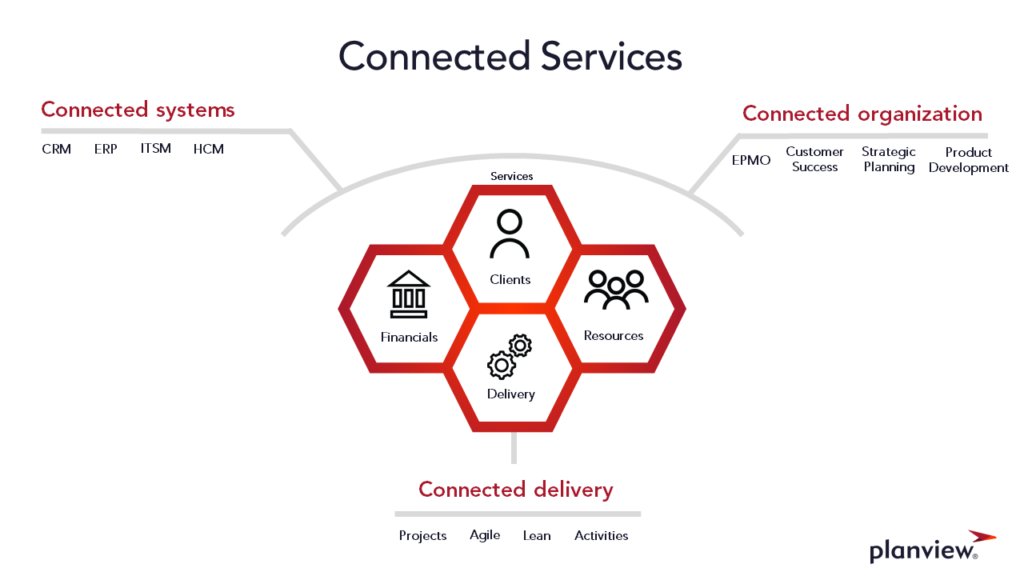
As technology solution providers emerge from the unprecedented volatility of the last couple of years, services leaders are asking what are the most important capabilities that they need to master? How should today’s toughest issues be addressed and tackled? What are the industry’s most important business challenges? What ways have customer expectations changed and increased?
These were some of the core questions and themes that were explored at the TSIA World: Interact Conference, which was held on May 16-18, 2022 in Orlando, Florida.
The 3-day event featured numerous keynote speakers, breakout sessions, and exhibitors from leading tech companies in the professional services space — including Planview PSA! Our team welcomed attendees to our booth and discussed strategies and solutions to help services organizations lead the future of connected services by connecting systems, data, work, organization, people, and customers.
Customers were able to learn more about it means to be a connected services organization, why it’s important, and what steps were necessary to make confident connections by attending this on-demand presentation session by Planview’s Director of Product Management Dave Blumhorst.

Disconnected services, systems, data, and people make it harder for services organizations and leaders to meet their goals. If you can relate, you may be losing revenue, diminishing customer experiences, and putting more pressure on profits margins.
What do organizations need to do to embrace the next phase of digital transformation?
Ask yourself the following questions:
- Are you connected to your company strategy?
- Are you connecting your sales with opportunity planning?
- Are you providing client work in the way that best works for them?
- Are you connected to customer success to ensure adoption and retention?
Below, we highlight five key takeaways from the TSIA World: Interact Conference that we believe should be top-of-mind for services leaders as they look ahead, clarify their vision, and plan their strategy around new ways of working, operating at the speed of business, and adapting to evolving business models.
1. Digital Transformation is Key
A conventional definition of digital transformation describes it as “the novel use of digital technology to solve traditional problems. These digital solutions enable inherently new types of innovation and creativity, rather than simply enhance and support traditional methods.” This definition is basically true, but it is not particularly insightful or instructive.
To achieve, establish and evolve digital transformation in the new world of work, TSIA in their new book, “Digital Hesitation: Why B2B Companies Aren’t Reaching their Full Potential” advises leaders to have all employees in the organization ask what it has dubbed the “North Star” question: If we had the data, we could do X and no longer have to do Y?
In a practical sense, this means today’s services leaders, together with their employees, must discover how to transform complexity strategically and sustainably into simplicity, while maturing from stage one (recurring revenue, as-a-service offers, and more connected products) to stage two (easing the customer journey to value and delivering more at lower costs).
The good news is that the technology to drive this new, modern concept of digital transformation already exists, and IT departments have plenty of choice. However, it is important for strategies and decisions to embrace the executive leadership perspective (aligning with organizational vision and priorities), and not just the technical perspective (addressing functional challenges and solving practical problems).
2. Leadership Buy-In and Adapting Processes Top Down is Critical
The Planview PSA team spoke with several services leaders at the TSIA World: Interact Conference. Naturally, each leader had specific challenges and goals unique to their respective organization and marketplace. However, many leaders shared a common trait: they were all focused and heavily involved in digital transformation.
Obviously, implementing best practices for digital transformation is a difficult — if not in some cases daunting — task. In its 2022 Professional Services Maturity™ Benchmark, Service Performance Insight (SPI) highlights some of the core challenges that leaders in services organizations face on this journey:
- Unclear strategy: Lack of clarity regarding target markets, target clients, and “why we win.” Difficulty capitalizing on market opportunities due to lack of alignment, lack of employee engagement and/or leadership, and cultural issues. No leverage to drive repeat sales, limited competitive differentiation, poor sales, marketing and service delivery execution.
- Lack of alignment: Unclear service charters — which is particularly a problem for embedded service organizations – with conflict between driving revenue and margin vs. helping the organization achieve market expansion and client adoption objectives.
- Silos: These exist in all companies and typically occur between groups/functions where responsibility and accountability are blurred. This often manifests as confusion and conflict around who is responsible for driving new service revenues: sales or delivery?
- Reactive not proactive: This happens when organizations lack real-time visibility into all facets of the business. As a result, leaders must rely on past business performance vs. spot trends and take advantage of them in real-time. Running the business by spreadsheet makes administration overly burdensome and error prone. Managers have no ability to analyze and recalibrate to take exploit changing market conditions, which leads to missed targets and a demoralized workforce.
- Skills imbalance: This is the logical extension of organizational silos. Organizations are not fully selling what it can deliver, or it is not delivering what has been sold. Consequences typically include excessive non-billable headcount, sub-par utilization, and both recruitment and retention difficulties (e.g. staffing projects is slow and burdensome).
Indeed, the importance of leadership buy-in and adapting processes top down cannot be underestimated. As the SPI warns: “When things go wrong, it most often starts at the top and then cascades downward throughout the organization, showing up in poor financial performance. Eliminating the root causes of dysfunction and inefficiency go a long way toward driving organizational success.”
3. Faster and More Strategic Decisions Are Essential
A major shift over the last couple of years is that customers are demanding that value is delivered faster, and in smaller iterations. The days of “big bang” implementations are over — or at least, they are fading — and they are being replaced by Agile delivery methods. This in turn is significantly accelerating the velocity of the end-to-end services lifecycle, and forcing organizations to scrutinize — and as necessary, refine and reinvent —business processes that replace complexity with simplicity. As TSIA mentioned in their in their Digital Hesitation eBook:
[D]igital transformation really begins with business process transformation. Companies must “lean out” their customer experience and the organizations that support them. And product managers have to end the practice of saying a product is ready for market when it’s still full of complexity and not integrated into the operations (marketing, sales, service) of the company. (Quotation marks and brackets in original).
The key takeaway is that accelerated, and more strategic decision-making is not just important for organizational success and growth. It is now critical for long-term organizational survival.
4. Keep the Customer at the Center
The Planview PSA team also had several in-depth conversations with leaders on how to keep customers at the center by better aligning services with strategy, providing better customer experience in changing services delivery models, and becoming more efficient.
On the modern services delivery landscape — where customer expectations are elevated, competition for customer loyalty is fierce, and the need to drive subscriptions is critical — PSA software can play a key role throughout engagements by measuring customer feedback, mitigating service risks, and improving delivery processes.
5. Create A Business Model That Aligns Services Experiences
There is now a heightened focus on customer success and aligning organization’s various services together for an optimal customer experience. Services must improve customer success and adoption. With the shift to DCX and XaaS, services play a more strategic role in transformation in all organizations. It’s not just about the software that you use or offer, it’s about evolving the business models and processes to create experiences that lead to customer value quicker. This can mean having services that focus on process and business model transformation. At Planview, we have Evolve Advisory services to aid customers in “evolving” their processes to be more mature and customer centric. We also align with TSIA in the ideal customer-oriented model with our Chief Customer Officer overseeing all of our services organizations as well as customer success – professional, support, and learning for example.
The Final Word
TSIA: Interact Spring 2022 highlighted that while services leaders face critical and difficult challenges ahead, they also have remarkable opportunities to drive a new and far more meaningful concept of digital transformation, replace complexity with simplicity, unlocking more value for customers than ever before, and increase revenues and profits. As Planview PSA, we are excited and energized about the state of the industry and the road ahead!
Next Steps
ON-DEMAND PRESENTATION: Are You a Connected Services Organization?
Learn what it means to be a connected services organization, why it’s important, and a few steps you can take to make confident connections in this on-demand presentation session(which was originally delivered live at TSIA: Interact Spring 2022), by Planview’s Director of Product Management Dave Blumhorst.




